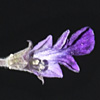Teucrium parviflorum is a rare perennial herb, 30-60 cm in height, lightly pubescent, that branches at the base. The branches' cross-section is square. The branches upper part form wide, loose pyramidal panicles. The branches and peduncles grow at right angles to the stems. The leaves are opposite, dissected twice or thrice to form narrow lobes with curling (revolute) margins.
The flowers are small, borne on long pedicels, and arranged two per node. The calyx is minutely tomentose, bell-shaped (campanulate), and about 5 mm in length. Sepals are even, pointed, and are of the same length as the tube of the corolla. The 7-8mm long corolla that has a single lip, is blue in color, and lightly pubescent on the outside. The flower has four stamens. The mericarps are pubescent.
Teucrium parviflorum grows in agricultural fields in heavy soils, in abandoned fields, and on rocky slopes in the northern transitional zone (Eastern Lower Galilee, the Gilboa), and in the southern Judean Mountains.
There are approximately 300 species in the genus Teucrium, with nearly worldwide distribution. The characteristic feature of the genus is the single lip (palate) of the corolla, from which 4 stamens extend. The lower lip of the corolla is divided into lobes, the central one of which is the largest. Most of the species are principally pollinated by bees. The Hebrew name is derived from the Arabic word meaning ‘curly’, probably due to the appearance of the leaves in a number of the species in the genus. The Latin name refers to King Teucer of Troy, who allegedly was the first to recognize the medicinal properties of the plant.
Written by Leora Keret






